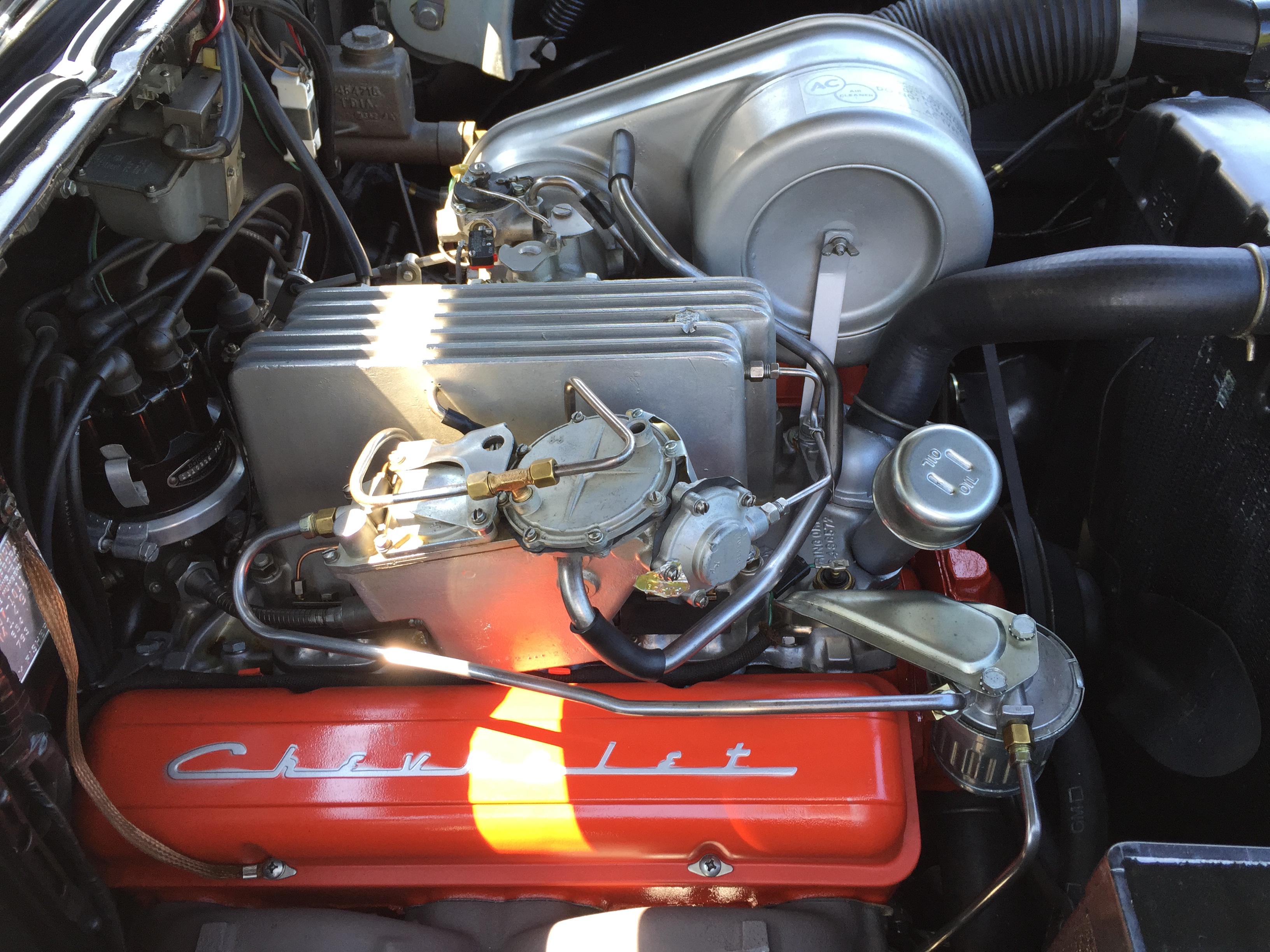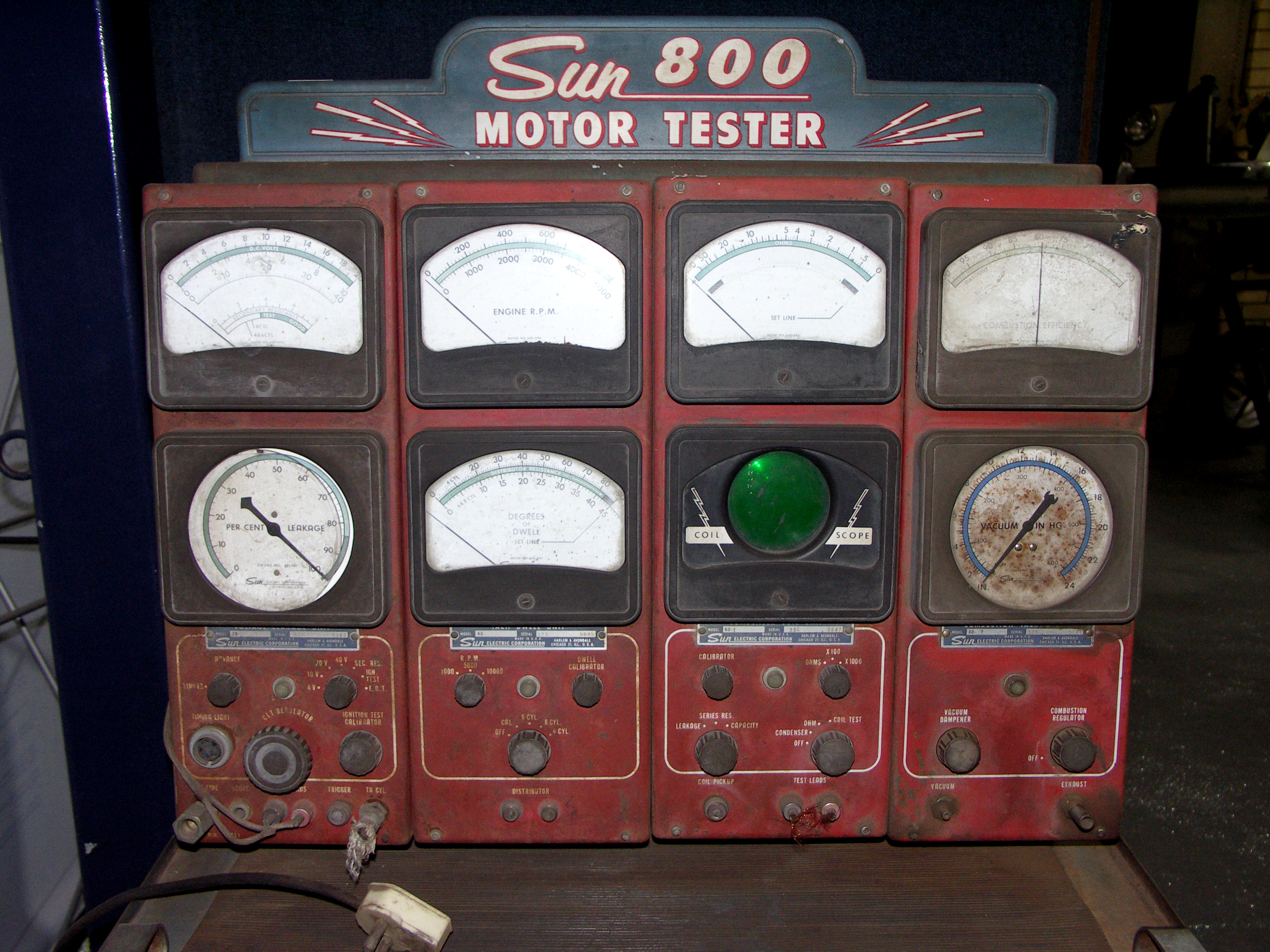|
Rochester Ramjet
The Rochester Ramjet is an automotive fuel injection system developed by the Rochester Products Division of General Motors and first offered as a high-performance option on the Corvette and GM passenger cars in 1957. It was discontinued partway through 1965 in favor of the Chevrolet Big Block as a performance option. Unlike electronic fuel injection systems that would become common decades later, the Ramjet is purely mechanical and relies on vacuum and pressure signals to measure airflow and meter fuel. History In the early 1950s, fuel injection was the topic of a significant amount of research by the auto industry in the US and internationally. Ed Cole, who had become the chief engineer of Chevrolet in 1952, pushed for Chevrolet to be the first GM brand to offer a fuel injection option on a production car. Much of the development of the Ramjet was done by engineer John Dolza, with supporting effort from Zora Arkus-Duntov. Dynamometer-based tests of a 265 cid small block engine ru ... [...More Info...] [...Related Items...] OR: [Wikipedia] [Google] [Baidu] |
1957 Chevrolet 210 Two-door Sedan With Fuel Injection At 2015 Macungie Show 2of4
1957 ( MCMLVII) was a common year starting on Tuesday of the Gregorian calendar, the 1957th year of the Common Era (CE) and ''Anno Domini'' (AD) designations, the 957th year of the 2nd millennium, the 57th year of the 20th century, and the 8th year of the 1950s decade. Events January * January 1 – The Saarland joins West Germany. * January 3 – Hamilton Watch Company introduces the first electric watch. * January 5 – South African player Russell Endean becomes the first batsman to be dismissed for having ''handled the ball'', in Test cricket. * January 9 – British Prime Minister Anthony Eden resigns. * January 10 – Harold Macmillan becomes Prime Minister of the United Kingdom. * January 11 – The African Convention is founded in Dakar. * January 14 – Kripalu Maharaj is named fifth Jagadguru (world teacher), after giving seven days of speeches before 500 Hindu scholars. * January 15 – The film ''Throne of Blood'', Akira Kurosawa's reworking of ''Macbeth'', is rele ... [...More Info...] [...Related Items...] OR: [Wikipedia] [Google] [Baidu] |
Engine Displacement
Engine displacement is the measure of the cylinder volume swept by all of the pistons of a piston engine, excluding the combustion chambers. It is commonly used as an expression of an engine's size, and by extension as a loose indicator of the power an engine might be capable of producing and the amount of fuel it should be expected to consume. For this reason displacement is one of the measures often used in advertising, as well as regulating, motor vehicles. It is usually expressed using the metric units of cubic centimetres (cc or cm3, equivalent to millilitres) or litres (l or L), orparticularly in the United States cubic inches (CID, cu in, or in3). Definition The overall displacement for a typical reciprocating piston engine is calculated by multiplying together three values; the distance travelled by the piston (the stroke length), the circular area of the cylinder, and the number of cylinders in the whole engine. The formula is: : \text = \text \times \frac \times ... [...More Info...] [...Related Items...] OR: [Wikipedia] [Google] [Baidu] |
Percolation
Percolation (from Latin ''percolare'', "to filter" or "trickle through"), in physics, chemistry and materials science, refers to the movement and filtering of fluids through porous materials. It is described by Darcy's law. Broader applications have since been developed that cover connectivity of many systems modeled as lattices or graphs, analogous to connectivity of lattice components in the filtration problem that modulates capacity for percolation. Background During the last decades, percolation theory, the mathematical study of percolation, has brought new understanding and techniques to a broad range of topics in physics, materials science, complex networks, epidemiology, and other fields. For example, in geology, percolation refers to filtration of water through soil and permeable rocks. The water flows to recharge the groundwater in the water table and aquifers. In places where infiltration basins or septic drain fields are planned to dispose of substantial amounts of ... [...More Info...] [...Related Items...] OR: [Wikipedia] [Google] [Baidu] |
Vapor Pressure
Vapor pressure (or vapour pressure in English-speaking countries other than the US; see spelling differences) or equilibrium vapor pressure is defined as the pressure exerted by a vapor in thermodynamic equilibrium with its condensed phases (solid or liquid) at a given temperature in a closed system. The equilibrium vapor pressure is an indication of a liquid's evaporation rate. It relates to the tendency of particles to escape from the liquid (or a solid). A substance with a high vapor pressure at normal temperatures is often referred to as '' volatile''. The pressure exhibited by vapor present above a liquid surface is known as vapor pressure. As the temperature of a liquid increases, the kinetic energy of its molecules also increases. As the kinetic energy of the molecules increases, the number of molecules transitioning into a vapor also increases, thereby increasing the vapor pressure. The vapor pressure of any substance increases non-linearly with temperature according ... [...More Info...] [...Related Items...] OR: [Wikipedia] [Google] [Baidu] |
Choke Valve
In internal combustion engines with carburetors, a choke valve or choke modifies the air pressure in the intake manifold, thereby altering the air–fuel ratio entering the engine. Choke valves are generally used in naturally aspirated engines to supply a richer fuel mixture when starting the engine. Most choke valves in engines are butterfly valves mounted upstream of the carburetor jet to produce a higher partial vacuum, which increases the fuel draw. In heavy industrial or fluid engineering contexts, including oil and gas production, a choke valve or choke is a particular design of valve with a solid cylinder placed inside another slotted or perforated cylinder. Carburetor A choke valve is sometimes installed in the carburetor of internal combustion engines. Its purpose is to restrict the flow of air, thereby enriching the fuel-air mixture while starting the engine. Depending on engine design and application, the valve can be activated manually by the operator of the engine ... [...More Info...] [...Related Items...] OR: [Wikipedia] [Google] [Baidu] |
Engine Tuning
Engine tuning is the adjustment or modification of the internal combustion engine or Engine Control Unit (ECU) to yield optimal performance and increase the engine's power output, economy, or durability. These goals may be mutually exclusive; an engine may be de-tuned with respect to output power in exchange for better economy or longer engine life due to lessened stress on engine components. Tuning can include a wide variety of adjustments and modifications, such as the routine adjustment of the carburetor and ignition system to significant engine overhauls. Performance tuning of an engine can involve revising some of the design decisions taken during the development of the engine. Setting the idle speed, air-fuel ratio, carburetor balance, spark plug and distributor point gaps, and ignition timing were regular maintenance tasks for older engines and are the final but essential steps in setting up a racing engine. On modern engines equipped with electronic ignition and fuel i ... [...More Info...] [...Related Items...] OR: [Wikipedia] [Google] [Baidu] |
Distributor
A distributor is an enclosed rotating switch used in spark-ignition internal combustion engines that have mechanically timed ignition. The distributor's main function is to route high voltage current from the ignition coil to the spark plugs in the correct firing order, and for the correct amount of time. Except in magneto systems and many modern computer controlled engines that use crank angle/position sensors, the distributor also houses a mechanical or inductive breaker switch to open and close the ignition coil's primary circuit. The first reliable battery operated ignition was the Delco ignition system developed by Dayton Engineering Laboratories Co. (Delco) and introduced in the 1910 Cadillac Model 30. This ignition was developed by Charles Kettering and was considered a wonder in its day. Atwater Kent invented his Unisparker ignition system about this time in competition with the Delco system. By the end of the 20th century mechanical ignitions were disappearing from ... [...More Info...] [...Related Items...] OR: [Wikipedia] [Google] [Baidu] |
Fuel Pump
A fuel pump is a component in motor vehicles that transfers liquid from the fuel tank to the carburetor or fuel injector of the internal combustion engine. Carbureted engines often use low pressure mechanical pumps that are mounted outside the fuel tank, whereas fuel injected engines often use electric fuel pumps that are mounted inside the fuel tank (and some fuel injected engines have two fuel pumps: one low pressure/high volume supply pump in the tank and one high pressure/low volume pump on or near the engine). Fuel pressure needs to be within certain specifications for the engine to run correctly. If the fuel pressure is too high, the engine will run rough and rich, not combusting all of the fuel being pumped making the engine inefficient and a pollutant. If the pressure is too low, the engine may run lean, misfire, or stall. A fuel pump is not necessarily required for the engine to function. The low-pressure fuel needed by a carbureted engine can be supplied simply by moun ... [...More Info...] [...Related Items...] OR: [Wikipedia] [Google] [Baidu] |
Regular Production Option
A Regular Production Option (RPO) is a General Motors standard coding for vehicle configuration options and began in 1970. These codes are a combination of 3 alphanumeric characters and refer to a specific option or modification to the vehicle including the paint color. Thus the specific configuration of a vehicle as it exits the factory can be described by specifying the base model and the complete list of RPO codes. Even a vehicle with no extra-cost options will have some RPOs, as information like the engine type and exterior paint color are always specified. Many RPO codes have been reused over the years. For example, the ZR1 performance option was available for the Corvette for the 1970, 1990 through 1995, 2009, and 2019 model years. In some cases (such as this), the RPO specifies a package with similar function (in this case performance) to previous uses of the code. For RPOs that never became notable the code may be reused for entirely dissimilar options. In 2018, the RP ... [...More Info...] [...Related Items...] OR: [Wikipedia] [Google] [Baidu] |
Chevrolet Small-block Engine .
{{SIA ...
Chevrolet small-block engine refers to one of a number of gasoline-powered vehicle engines manufactured by the General Motors company. These include: * The III, IV, V generation of LS-based GM engines. * The I, II generation of non-LS Chevrolet small-block engines. * Or the Chevrolet Gemini small-block engine The Chevrolet Gemini small-block engine is a dual-overhead cam (DOHC) V8 engine designed by General Motors. While technically a small-block engine due to its bore spacing of 4.4 inches,, General Motors engineers don't consider it to be a part o ... [...More Info...] [...Related Items...] OR: [Wikipedia] [Google] [Baidu] |
Fuel Injection
Fuel injection is the introduction of fuel in an internal combustion engine, most commonly automotive engines, by the means of an injector. This article focuses on fuel injection in reciprocating piston and Wankel rotary engines. All compression-ignition engines (e.g. diesel engines), and many spark-ignition engines (i.e. petrol engines, such as Otto or Wankel), use fuel injection of one kind or another. Mass-produced diesel engines for passenger cars (such as the Mercedes-Benz OM 138) became available in the late 1930s and early 1940s, being the first fuel-injected engines for passenger car use. In passenger car petrol engines, fuel injection was introduced in the early 1950s and gradually gained prevalence until it had largely replaced carburettors by the early 1990s. The primary difference between carburetion and fuel injection is that fuel injection atomizes the fuel through a small nozzle under high pressure, while a carburettor relies on suction created by intake ai ... [...More Info...] [...Related Items...] OR: [Wikipedia] [Google] [Baidu] |





.jpg)